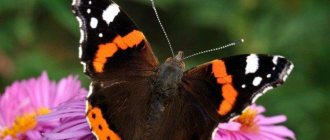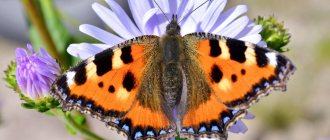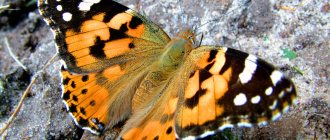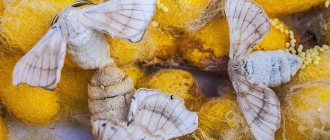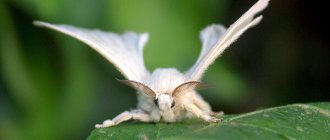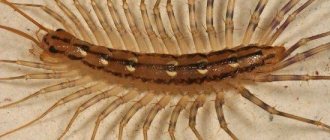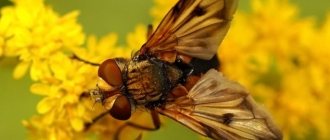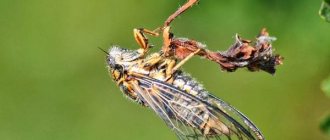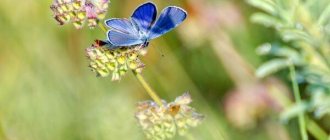Origin of the species and description
Photo: Admiral Butterfly
Lepidopterists, people who devote their lives to butterflies, often give them names associated with mythology. Our beauty received her Latin name atalanta, inheriting it from the daughter of the king of Arcadia, whom her parents, expecting the birth of her son, threw into the forest, where she was nursed by a bear.
Admirals belong to the Vanessa family. What it has in common with other representatives of the nymphalid family is the presence of brushes on the shortened front legs; there are no claws on them, and the veins on the wings do not have thickenings. These insects are called lepidoptera because their wings are covered with scales modified by hairs of different shapes. They are placed along the wing in rows, like tiles, with the base directed towards the body, the free edge towards the end of the wings. The scales contain pigment grains responsible for coloring.
Video: Butterfly Admiral
Some scales, called androconia, are associated with glands that secrete an odorous secretion. This is how males attract their partners by smell. Like all representatives of the detachment, admirals appeared relatively recently, from the Tertiary period. The fore wings of these vanes are larger than the hind wings, interlocking with each other using a chitinous frenulum. Like all nymphalids, when open, the wings of the admiral are brightly colored; when folded, the lower part of the surface is camouflaged.
Interesting fact: When folded, the large front wings remain inside, and from behind the rear wings only the very top corner is visible.
Classification
Admiral is the type species of the genus Vanessa. It is divided into two geographically isolated subspecies. Data on intraspecific taxonomy are provided by Field and Markku Savela on the website. (checked 10/06/2019).
Below is information about the admiral varieties.
- Vanessa atalanta atalanta ( Linnaeus , 1758)
Found in Eurasia and North Africa. The Eurasian subspecies has a narrower white band at the top of the forewings and smaller black spots on the orange band on the hindwings.
- Vanessa atalanta rubria (Fruhstorfer, 1909)
Lives in North America. This subspecies shows slight variations in color throughout the year. Butterflies of the summer generation are somewhat darker and larger than spring individuals, and the stripe on the forewing is narrower and more reddish in color.
Photo credit: Emmanuel Boutet, CC BY-SA 3.0
Appearance and features
Photo: Butterfly of Russia Admiral
The front wing has a size of 26-34.5 mm, with a span of 50-65 mm. The upper surface is black, velvety brown.
Characteristic coloration of the front wings:
- there is a small tooth on the outer side of the ending;
- at the top a row of white spots runs parallel to the outer edge;
- a little closer to the head there is one wide, elongated spot;
- A curved carmine-red wide stripe runs diagonally.
Hind wing color:
- a carmine-red wide border runs along the lower edge;
- each of the five segments of the bright stripe has a black dot;
- in the extreme lower corner there is a double blue spot with a black outline.
A wavy, thin white stripe borders all four wings. The lower surface is paler in coloring, but very pockmarked. The front wings are ornamentally similar to the upper surface, but they are not so bright, complemented by bluish areas almost in the center of the upper edge. Coloring of the lower surface of the rear wings:
- the tobacco-gray background is dotted with black, dark-brown lines, small circles, and grayish stains;
- a larger whitish spot is located in the very center of the upper edge.
The back of the body is dark, black or brown, the abdomen is lighter brown or tobacco color. The chest is divided into three parts, each of which contains a pair of limbs. The role of the oral apparatus is performed by the proboscis. The butterfly's compound eyes are covered with bristles and have a crystalline structure. The antennae are club-shaped thickened in the upper part; they act as one of the sense organs. with their help, nymphalids can detect the slightest vibrations in the air and sense aromas.
Interesting Facts
Butterfly hives, why is it called that? The name of the species in Russian and Latin (Nymphalisurticae) is associated with the food plant of the larvae - nettle. Adults are often seen fluttering above the bushes of the plant during oviposition. The close connection between the butterfly and nettle was the reason for choosing the name.
By observing the behavior of hives, you can predict the weather. If on a clear day a butterfly rushes about in search of shelter, it means that in a few hours it will rain heavily.
How many legs does a hives butterfly have? Lepidopteran insects have three pairs of legs attached to the chest. The family of nymphalids, to which the urticaria belongs, has a characteristic feature. The front legs of moths are reduced. They are greatly shortened and are not used when walking. The limbs are devoid of claws. The modified legs are covered with long bristles that serve as organs of touch. Butterflies move on two pairs of legs - middle and hind. But the limbs are used for moving short distances, as well as landing and taking off.
Where does the admiral butterfly live?
Photo: Admiral Butterfly in Russia
The geographic range of distribution of Vanessa atlanta extends in the Northern Hemisphere from the north of Canada to Guatemala - in the west, from Scandinavia to the European part of Russia, further south to Africa, its northern part, and eastern China. It can be seen in the Atlantic on Bermuda, Azores, Canary Islands, in the Pacific Ocean on Hawaii, and other Caribbean islands. The insect was introduced to New Zealand and breeds there.
Nymphalidae cannot survive cold winters, but during migrations it can be found from the tundra to the subtropics. Unable to endure extreme frosts, the fluttering beauties migrate to the southern regions, to warmer places. This representative of Vanessa loves damp forests, marshy areas, water meadows, and gardens with regular irrigation. This is one of the last butterflies that can be found in northern Europe before the onset of winter. In mountain ranges it can live at altitudes of up to 2700 meters.
What does the admiral butterfly eat?
Photo: Admiral Butterfly
Adults feed on fruits; they can be seen on carrion; they love the fermented juice of overripe fruits. Sugary liquid secretions from trees and bird droppings also serve as food. At the end of summer, Vanessas sit on overripe fruits. Among flowers, if there is no other food, they prefer aster, spurge, alfalfa, and red clover.
Caterpillars eat leaves of stinging nettle, stinging nettle, and other plants from the Urticaceae family. They live on hops, plants of the thistle genus. The oral apparatus of an adult is unique. The soft proboscis, like a steel watch spring, can open and curl. It is mobile, elastic and adapted to absorb liquid nectars and plant juices.
Interesting fact: On the front legs of an insect there are sensitive villi, which are equipped with taste buds; the admiral takes the first “sample” by sitting on a fruit or tree sap.
Home content
Some fans of the world of wildlife want to buy an original pet, for example, a butterfly, the name of which comes from the word denoting a high naval rank - Admiral. Indeed, it is possible to keep them at home, but it is best to keep a caterpillar rather than an adult. She will adapt more easily and will not harm the environment by eating plants.
In order for the beautiful Admiral to feel comfortable, you should prepare a place for the caterpillar - a small aquarium without water, in which you need to plant food plants. The top of the container is covered with a mesh. It is important that the insect has constant access to clean air. You can create the necessary humidity by sprinkling the leaves of plants with water from a spray bottle. Particular attention should be paid to this at the pupal stage.
In order for the insect to spread its wings, a vertical branch should be placed in the aquarium. Feeding your pets is not difficult - you need to include honey and fruit juices in their diet. For example, to prepare a honey drink, 1 tsp. sweets are diluted in 6 tsp. clean water and then poured onto a flat saucer. In addition, butterflies are very fond of carrion, so they happily feast on cut slices of apples, pears, and berries. And it’s not scary if they are a little fermented.
The Admiral butterfly, with its unusually bright coloring, brings undoubted benefits because it participates in plant pollination. Only voracious caterpillars that feed on nettles and hops cause harm.
Features of character and lifestyle
Photo: Admiral Butterfly from Russia
The winged insect has fast and erratic flight, speeds can reach 15 km/h. When migrating, the admiral moves over vast distances, and in order not to lose a lot of energy, he rises high into the sky and flies using air currents. Such flights can be significant: from one continent to another.
During the winter months, depending on the habitat, the butterfly falls asleep until spring, appearing with a brighter coloring, but they can be seen fluttering on sunny winter days in the southern regions.
Interesting fact: Vanessa Atlanta needs brightly colored wings so that individuals of this species can recognize each other from a distance. Up close, they are recognized by the smell emitted by androconia.
When some insects, hiding in the crevices of the bark or leaves, fall asleep, others set off on their way to warmer climes and spend the winter there. For winter periods, European individuals choose the north of Africa, and North American individuals choose the Atlantic islands. Specimens that remain for the winter do not always survive until spring, however, like those that make long, dangerous migrations. Flight periods may vary depending on the habitat: from early May-June to September-October.
Interesting fact: These nymphalids have color vision, seeing yellow, green, blue and indigo. Since admirals do not have lateral filter pigments, they cannot see shades of the orange-red spectrum.
Security
In Russia, the admiral butterfly was rarely seen - the population size has seriously decreased due to the treatment of fields with chemicals. The Red Book has contained information about it since 1997, but then the species was excluded from the publication. The situation remains difficult only in the Smolensk region. In this area, the population has a declining status.
In 2022, the number of admirals has increased significantly in the European part of the country. Scientists say that similar rapid rises and falls in numbers occur in most insects. Why is that? There are many factors that are difficult to predict. Scientists identify the following two most popular factors, explaining the natural phenomenon briefly:
- If there are frosts at the beginning of summer, fewer individuals are born.
- Parasitoid insects use caterpillars to feed their own offspring. When the number of such pests decreases, the number of butterflies increases.
The life of butterflies is negatively affected by deforestation, plowing of meadows and the use of chemicals to treat plantings. In Russia, admirals are most often found in meadows, along roads, near forests, and also in mountainous areas. Butterflies live in the Urals and the Eastern Caucasus, Karelia and the central part of the country. In recent years, insects with colorful wings have become frequent guests on the shores of the White Sea. Local residents say that this is a real invasion.
The butterfly chooses its habitat for a reason. The number of generations depends on it - there can be from one to three offspring per year.
The climatic conditions of most regions of Russia are not suitable for fastidious insects. The Admiral is one of the few exceptions. A brightly colored butterfly, similar to the bud of an exotic flower, pleases the eye from spring to autumn. The fragile insect does not harm cultivated plants. Therefore, do not rush to get rid of the furry caterpillars if you suddenly see them in the garden or beds, because soon it will turn into a colorful butterfly with an unusual sea name. Read more about the benefits butterflies can bring.
On the front wings there are white spots in the corners, which are separated by a bright red stripe. The same stripe runs along the edge of the lower wing. These stripes gave the butterfly its name: in the old days, admirals had red stripes on their trousers, and they wore red ribbons over their shoulders.
The Admiral's caterpillar is brown-red, with yellow stripes, spines and dots. They live on the leaves of nettles and thistles. The Admiral butterfly is found on forest edges, clearings, meadows, on sunny river banks, and along roadsides. Flight time is from May to October.
Social structure and reproduction
Photo: Butterfly Admiral Russia
Admirals are creatures with complete transformation, going through all stages from egg to larva, which turns into a pupa, and then regenerates into an adult. Before mating, males persistently court their chosen ones, while simultaneously repelling the attacks of rivals. They fly around their territory up to 30 times per hour. During this time, they manage to interact with other applicants 10-15 times, and this activity continues throughout the day.
The area of the plot, which has the shape of an oval, occupies 2.5-7 m in width and 4-13 m in length. When an intruder appears, the male drives him away, rising in a vertical spiral to tire out the enemy. After expelling the enemy, the owner of the site returns to his territory and continues to patrol it. Only the hardiest individuals are able to win a female in order to leave offspring. Males often sit in bright, sunlit areas and wait for the females to fly up.
Interesting fact: Depending on their habitat, admirals can have one, two or three generations of offspring per year.
A green, oval, ribbed egg (about 0.8 mm) is laid by females on the top of a leaf of a food plant. A week later, when emerging, the size of the greenish larva is 1.8 mm. As it grows and molts (5 stages of development in total), the body length changes to 2.5-3 cm, and the color also changes. It may vary slightly, but most often it is black with white dots around the body.
The caterpillars have spines with reddish bases; they are arranged in a ring-like pattern in segments. There are seven rows of spines along the body. A stripe of white or cream spots runs along the sides of the body. The caterpillars' diet is leaves, most often from the nettle family. They hide from enemies in leaf plates folded in half.
Interesting fact: When growing larvae in different laboratory conditions, at temperatures around 32°, the pupal stage period lasted 6 days. At 11-18° this time extended and amounted to 47-82 days. In warm conditions, the pupae and butterflies that emerged from them were brighter.
At the end of the last stage, the caterpillar stops feeding. When building a house for the next stage of life, she eats the base of the leaf, but leaves the veins, folds it in half and glues the edges. The shelter hangs freely on the veins, in it a nondescript, gray pupa with short spines and golden spots is located upside down. Its size is about 2.2 cm.
Bibliography
- Anikin V.V., Zolotukhin V.V., Shulaev N.V. An outbreak of the admiral Vanessa atalanta (L., 1758) (Lepidoptera, Nymphalidae) in Volga cities in 2022 // Entomological and parasitological studies in the Volga region. 2022. – No. 15. –P. 111-112.
- Gorbunov P. Yu. Olshvang V. N. Butterflies of the Middle Urals. Reference guide. – Ekaterinburg: Socrates, 2007. – 352 p.
- Korshunov Yu. P. Lepidoptera of Northern Asia. M.: Partnership of Scientific Publications KMK, 2002. P. 58. (Series: Keys to the flora and fauna of Russia. Issue 4.).
- Lvovsky A. L., Morgun D. V. Mace lepidoptera of Eastern Europe. – M.: Partnership of Scientific Publications KMK, 2007. – 443 p. (Series: Keys to the flora and fauna of Russia. Issue 8).
- Nekrutenko Yu. P. Lepidoptera of the Crimea: Key. – Kyiv: Naukova Dumka, 1985. – 152 p.
- Shulaev N.V., Petrov N.G., Shulaev M.V. Lepidoptera of Tatarstan. – Kazan: JSC “New Knowledge”, 2005. – 40 p.
- Atay T., Özdemir M., Kara K. Tachinids (Diptera: Tachinidae) Reared from Lepidopterous Hosts in Kayseri Province with New Host Records // Journal of the Entomological Research Society. – – Vol. 20, Iss., 2. – P. 103-108,
- Baker RR The geographical origin of the British spring individuals of the butterflies Vanessa atalanta (L.) and cardui (L.) // Physiological Entomology. – 1972. – Vol. 46, Iss. 2. – P. 185-196.
- Baur H. Pushing the limits – two new species of Pteromalus (Hymenoptera, Chalcidoidea, Pteromalidae) from Central Europe with remarkable morphology // ZooKeys. – – Vol. 514. – P. 43-72.
- Benvenuti, S., P. Dall' Antonia & P. Ioale. Directional preferences in the autumn migration of the red admiral (Vanessa atalanta) // Ethology. – – Vol. 102. – P. 177-186.
- Bryant-Simon R., Thomas-Chrls D. & Bale-Jeffrey S. Nettle-feeding nymphalid butterflies: Temperature, development and distribution. // Ecological Entomology. – – Vol. 22. – P. 390-398.
- Bitzer RJ, Shaw KC Territorial behavior of the red admiral, Vanessa atalanta (Lepidoptera: Nymphalidae) I. The role of climatic factors and early interaction frequency on territorial start time // Journal of Insect Behavior. 1995. – 8, Iss. 1. – P. 47–66.
- Brattström O., Akesson S. and Bensch S. AFLP reveals cryptic population structure in migratory European red admirals (Vanessa atalanta) // Ecological Entomology. – – Vol. 35. – P. 248–252
- Brattström O., Bensch S., Åkesson S., Wassenaar LI, Hobson KA Understanding the migration ecology of European red admirals Vanessa atalanta using stable hydrogen isotopes // Ecography. – – T. 33, No. 4. – P. 720-729.
- Cuadrado M. The year-round phenology of the migratory Red Admiral Vanessa atalanta (Lepidoptera: Nymphalidae) in a Mediterranean area in southern Spain // European journal of entomology. – – Vol. 114. – P. 517-525,
- Field WD Butterflies of the genus Vanessa and of the resurrected genera Bassaris and Cynthia (Lepidoptera: Nymphalidae) // Smithsonian Contributions to Zoology. – – T. 84. –P. 1-105.
- Hensle J. Die Überwinterung von Vanessa atalanta (Linnaeus, 1758) am Kaiserstuhl (Südwestdeutschland) (Lepidoptera, Nymphalidae) // Atalanta. – – Bd. 32. – P. 379-388.
- Hensle J. Weitere Beobachtungen zu Überwinterung und Südwanderung von Vanessa atalanta (Linnaeus, 1758) am Kaiserstuhl (Südwestdeutschland) (Lepidoptera, Nymphalidae) // – 2002. – Bd. 33. – S. 47-56.
- Masnadi-Yazdinejad A., Jussila R. & Riedel M. 2010: The Iranian fauna of the subfamilies Acaenitinae, Banchinae, Campopleginae, Ophioninae and Tryphoninae (Hymenoptera: Ichneumonidae) with some new records // Entomol. Fennica. – 21. – P. 70–83.
- Riedel M., Çoruh S., Özbek H. New Records and Little-Known Ichneumoninae (Hymenoptera: Ichneumonidae) from Turkey, with Description of the Male of Melanichneumon glaucatoriops Heinrich // Journal of the Entomological Research Society. – – Vol. 13, Iss., 2. – P. 105-112,
- Obregón R., M.R. Shaw, J. Fernández-Haeger & D. Jordano Parasitoid and ant interactions of some Iberian butterflies (Insecta: Lepidoptera) // SHILAP Revista de Lepidopterología. – – Vol. 43 (171). – P. 439-454.
- Smyth F. and Nash DW Overwintering of the Red Admiral butterfly (Vanessa atalanta (L.)) on Howth Peninsula, Co. Dublin // The Irish Naturalists' Journal. – – Vol. 29, part 2. – P. 81-86
- Stefanescu C. The nature of migration in the red admiral butterfly Vanessa atalanta: evidence from the population ecology in its southern range // Ecological Entomology. 2001. – T. 26, No. 5. – P. 525-536.
- Swanson HF, Monge-Nájera J. The effects of methodological limitations in the study of butterfly behavior and demography: a daily study of Vanessa atalanta (Lepidoptera: Nymphalidae) for 22 years // Revista de biologia tropical, 2000. – T. 48, No. 2-3. – 605-614.
- Vane-Wright RI & Hughes HWD Did a member of the Vanessa indica complex (Nymphalidae) formerly occur in North America // Journal of The Lepidopterists' Society. 2007. – 61, Iss. 4. – P. 199-212.
- Vanhara, J., Tschorsnig, H.-P., Herting, B., Mückstein, P. & Michalková, V. Annotated host catalog for the Tachinidae (Diptera) of the Czech Republic // Entomologica fennica. 2009. – 20, Iss. 1. – P 22-48
- Wagner DL Caterpillars of Eastern North America: A Guide to identification and natural history. – Princeton: Princeton University Press, 2005. – 512 p.
- Savela M. Vanessa Fabricius, 1807 // Lepidoptera and Some Other Life Forms.
- The myth of Atalanta: a metaphor for psychological growth // Club of Jungian fairy tale therapy “In the labyrinth of fairy tales”. https://vlabirinteskazok.ru/biblioteka/knigi/mif-ob-atalante.
- Vanessa atalanta (Linnaeus, 1758) – Vanessa admiral (Admiral) // Butterflies of the Caucasus and southern Russia. .
- Vanessa atalanta (Linnaeus, 1758) – Admiral // Bestimmungshilfe für die in Europa nachgewiesenen Schmetterlingsarten. https://www.lepiforum.de/lepiwiki.pl?Vanessa_Atalanta
- Red Admiral Vanessa atalanta (Linnaeus, 1758) // Butterflies and Moths of North America. https://www.butterfliesandmoths.org/species/vanessa-atalanta.
- Red Admiral Vanessa atalanta // UK Butterflies. https://www.ukbutterflies.co.uk/species.php?species=atalanta.
- Red Admiral (Vanessa atalanta) // UK Butterfly Monitoring Scheme. https://www.ukbms.org/SpeciesFactsheets?speciesId=122.
- The red admiral butterfly // Saga magazine. https://www.saga.co.uk/magazine/home-garden/gardening/wildlife/butterflies/red-admiral-butterfly
Author of the article: Pestov Sergey Vasilievich, entomologist, candidate of biological sciences
Did you like the article? Share with your friends:
Natural enemies of admiral butterflies
Photo: Admiral Butterfly
Thanks to their uneven, rapid fluttering, these winged creatures are difficult to catch, since it is impossible to predict where they will direct their flight next. Bright admirals are very trusting and can sit on an outstretched hand. When the wings are folded, it is difficult to notice them against the background of the tree bark where they hide to sleep. They become more available when they drink nectar or become slower before hibernation.
Birds are the main enemies of adults, although some are scared off by their bright colors. Among those who can still hunt flying butterflies are bats. The shaggy appearance of the larvae scares away many who want to feast on them. Of all the birds, perhaps only cuckoos risk diversifying their diet with caterpillars. Rodents also include these lepidopterans in their menu, regardless of their developmental stage. Amphibians and reptiles of various species prey on Vanessa atlanta and its larvae. Caterpillars have their own enemies among insects.
They can be eaten by representatives of:
- Coleoptera;
- spiders;
- dragonflies;
- os;
- praying mantis;
- ants.
